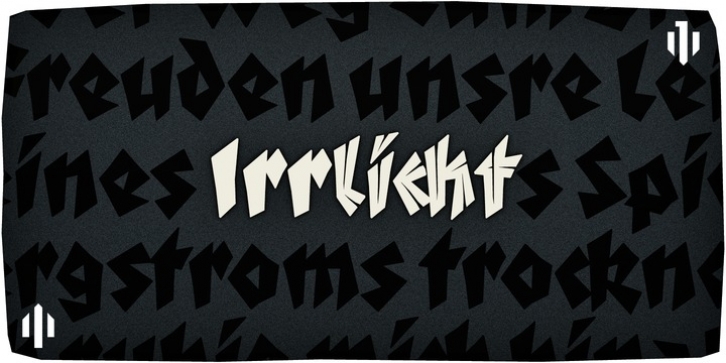


 Irrlicht was created by Christian Kleukens, A. Hausel and released by Aarhaus. Irrlicht includes 2 styles and household package options. p > Irrlicht is based on C. H. Kleukens' 1923 typeface Judith Type. Whilst Dunkle Irrlicht is a fairly loyal rendition and extension of Kleukens' typeface, the Licht style was initially included as a stand-alone stencil variation; yet, the 2 styles work completely together-- for various subtleties, for emphasis or just stacked/layered.
Irrlicht was created by Christian Kleukens, A. Hausel and released by Aarhaus. Irrlicht includes 2 styles and household package options. p > Irrlicht is based on C. H. Kleukens' 1923 typeface Judith Type. Whilst Dunkle Irrlicht is a fairly loyal rendition and extension of Kleukens' typeface, the Licht style was initially included as a stand-alone stencil variation; yet, the 2 styles work completely together-- for various subtleties, for emphasis or just stacked/layered. Irrlicht is equipped with upper- and lowercase ligatures, contextual and stylistic alternates, fractions, superior and inferior figures, extended language support and a couple of additional goodies.
Additional details-- How Irrlicht pertained to life
Christian Heinrich Kleukens cut his Judith Enter 1923, at the peak of German expressionism, solely for publications with the Ernst-Ludwig-Press, such as a restricted series of biblical prints-- the first being the Book of Judith, hence the original's name.
I came across this typeface a number of years earlier in a great little 1930 booklet of the Gutenberg-Gesellschaft and was struck by its strong darkness on paper and its apparently basic, crude letterforms. The lack of a long-ſ in the final version of Judith Type-- quite unusual for a German typeface of that time-- includes to this feel of ignorance and spontaneity *. Judith Type appeared to me like a semi-blackletter cousin of Rudolf Koch's typeface Neuland (cast in the very same year). Besides its obvious affinity with expressionism, it shows a lot of that deeply spiritual craftsmanship of the age-- much like Neuland.
A couple of months later on, when I was dealing with a stencil project and looking for a typeface that might be cut into thin wood plates quickly, I kept in mind those dark, sharp letters that seemed to be doing not have any curves at all.
After increasing the size of a couple of letters and tracing them by hand, the entire set was redrawn digitally, utilizing just straight lines. As for spacing, the objective was to keep the letters tight however to avoid touching characters-- without settling all the original's tension and rhythm. Purposeful kerning, subtle contextual alternates and ligatures help to handle crucial glyph combinations.
Two additional variations were developed: a stencil variation with open counters and, in reference to a popular style of the 1920s and inspired by dry, cracked wood, an inline variation. These 2 additional designs were later on combined into one font-- Lichte ** Irrlicht was born. - AARHAUS
* Consequently, the initial typeface's German eszett is just a ligature of the "round s" and standard z. In some of his publications, Kleukens gives with using eszett altogether and sets double s instead. Irrlicht, nevertheless, does include a more common eszett (ß); the original, to name a few more devoted letter kinds, can be accessed through the stylistic sets feature
** licht-- actually intense-- being the German term for inline typefaces-- not to be confused with leicht (light)
Font Family:
· Irrlicht Dunkle
· Irrlicht Lichte
Tags: art, blackletter, broken, dark, expressionism, expressionist, german, hands, headline, inline, lithography, loud, manicule, no curves, poster, sharp, stencil, symbol, ultra, woodcut
